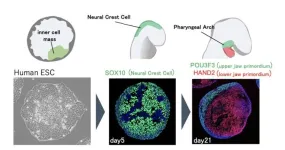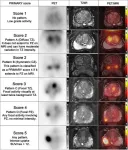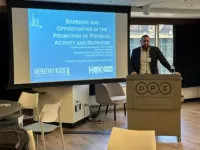Cells putting on a face
Kyoto University discovers formation of branchial arches modeling facial primordium
2024-04-12
(Press-News.org)
Kyoto, Japan -- Mother Nature is an artist, but her craft of creating animal faces requires more than a paintbrush and palette. Such highly complex shapes originate from their respective transient neural crest cells.
These embryonic pluripotent cells within the facial primordium—the early development form—may be necessary for forming proper facial structures. However, analyzing the molecular mechanisms in such early stages of development poses many technical challenges.
Now, a group of Kyoto University researchers have produced neural crest cell-rich aggregates from human pluripotent stem cells and developed a method to differentiate them in cell populations with a branchial arch-like gene expression pattern.
"After the cell populations differentiate into precursors of maxillary and mandibular cells in response to external signalling factors, these populations spontaneously form patterns of the facial primordium," explains Yusuke Seto of KyotoU's Institute for Medical and Biological Research.
This cartilage-like structure, reminiscent of Meckel’s cartilage, is formed locally within the aggregates.
"We aim to establish a model for studying early facial development by using the properties of human pluripotent stem cells to generate in vitro tissue resembling the bronchial arch of the primordial face," adds Ryoma Ogihara, also of the Institute.
Researchers are examining the various developmental processes that cause interspecific and individual differences in facial structure to explain conditions such as craniofacial disorders.
"Using our in vitro model could help us better understand and control signal integration during the fate determination of the branchial arch and cartilage formation in the face and elsewhere. We hope our technology can contribute to the development of cellular materials for new regenerative medicine," adds Mototsugu Eiraku, also of the Institute.
###
The paper "In vitro induction of patterned branchial arch-like aggregate from human pluripotent stem cells" appeared on 14 February 2024 in Nature Communications, with doi: 10.1038/s41467-024-45285-0
About Kyoto University
Kyoto University is one of Japan and Asia's premier research institutions, founded in 1897 and responsible for producing numerous Nobel laureates and winners of other prestigious international prizes. A broad curriculum across the arts and sciences at undergraduate and graduate levels complements several research centers, facilities, and offices around Japan and the world. For more information, please see: http://www.kyoto-u.ac.jp/en
END
ELSE PRESS RELEASES FROM THIS DATE:
2024-04-12
WASHINGTON (April 11, 2024) – Vosoritide’s first global phase 2 study showed an average increased growth rate of 1.8 cm per year in children with hypochondroplasia, a genetic cause of short stature in children, according to researchers from Children’s National Hospital.
“This is the first medicine that has been developed to specifically target the pathway involved in hypochondroplasia,” says Andrew Dauber, M.D., chief of Endocrinology at Children’s National. “These findings will help inform future studies of vosoritide for addressing growth disorders.”
This clinical trial ...
2024-04-12
Inside the brains of people with psychosis, two key systems are malfunctioning: a "filter" that directs attention toward important external events and internal thoughts, and a "predictor" composed of pathways that anticipate rewards.
Dysfunction of these systems makes it difficult to know what’s real, manifesting as hallucinations and delusions.
The findings come from a Stanford Medicine-led study, publishing April 11 in Molecular Psychiatry, that used brain scan data from children, teens and young adults with psychosis. The results confirm ...
2024-04-12
Megan Reiter, an assistant professor of physics and astronomy at Rice University, has won a National Science Foundation (NSF) CAREER Award to investigate the influence of neighboring stars on the formation of planets.
The research funded by Reiter’s five-year, $951,446 NSF grant will shed light on a phenomenon that could significantly impact our understanding of how planets are born.
“By exploring the intricate interplay between stars, planets and their environments, we hope to clarify the key forces that shape planet formation,” Reiter said.
Observations show planets form in the ...
2024-04-12
Join the International Society of Stem Cell Research (ISSCR) to celebrate Earth Day on 22 April 2024 by diving into the science of conservation, where the potential of stem cells is harnessed to foster a more sustainable and biodiverse future. This enlightening webinar co-hosted by Ashlee Hutchinson and Jun Wu will spotlight the revolutionary intersection of induced pluripotent stem cells (iPSCs), embryo models and genome engineering technologies with the noble cause of species preservation.
As our planet faces unprecedented biodiversity loss, this program will unveil how cutting-edge scientific advancements offer a lifeline for endangered species, ...
2024-04-12
NORMAN, OKLA. – Hanping Ding, Ph.D., an assistant professor in the School of Aerospace and Mechanical Engineering at the University of Oklahoma, has been awarded a $3.1 million grant from the Hydrogen and Fuel Cell Technologies Office in the Department of Energy through the Bipartisan Infrastructure Law to further research in clean hydrogen production. The funding is part of a $750 million effort in President Biden’s Investing in American agenda. The money from the Department of Energy will go to 52 projects across 24 states to position the United States as a global leader in the clean hydrogen industry.
The combined outcomes of the 52 projects should allow the ...
2024-04-12
Professor dr. Linda Amaral-Zettler, Research Leader at NIOZ Royal Netherlands Institute of Sea Research and the Chair in Marine Microbiology at the University of Amsterdam has been awarded a prestigious Advanced ERC-grant by the European Commission today. Amaral-Zettler receives almost 3,5 million euros for her research into biodegradation in the marine environment. “Biodegradable sounds really nice”, she admits. “But before we repeat the mistakes we’ve made with fossil-fuel-based plastics back in the last millenium, we really want to understand how these materials interact with marine life and how long they last in the environment.” “Biodegradable ...
2024-04-11
We depend on our cells being able to divide and multiply, whether it’s to replace sunburnt skin or replenish our blood supply and recover from injury. Chromosomes, which carry all of our genetic instructions, must be copied in a complete way during cell division. Telomeres, which cap the ends of chromosomes, play a critical role in this cell-renewal process—with a direct bearing on health and disease.
The enzyme telomerase plays a key role in maintaining the length of telomeres as chromosomes replicate during ...
2024-04-11
Modern biology textbooks assert that only bacteria can take nitrogen from the atmosphere and convert it into a form that is usable for life. Plants that fix nitrogen, such as legumes, do so by harboring symbiotic bacteria in root nodules. But a recent discovery upends that rule.
In two recent papers, an international team of scientists describe the first known nitrogen-fixing organelle within a eukaryotic cell. The organelle is the fourth example in history of primary endosymbiosis — the process by which a prokaryotic cell is engulfed by a eukaryotic cell and evolves beyond symbiosis into an organelle.
“It’s very rare that organelles ...
2024-04-11
Reston, VA—PET/MRI can improve diagnostic accuracy for prostate cancer patients and help avoid unnecessary biopsies, according to new research published in the April issue of The Journal of Nuclear Medicine. By applying the PRIMARY scoring system to PET/MRI results, researchers found that more than 80 percent of unnecessary biopsies could be avoided at the expense of missing one in eight clinically significant prostate cancer cases.
The Prostate Imaging Reporting and Data System (PI-RADS) is a five-point ...
2024-04-11
The concept of “One Health” – which emphasizes the relationship between human, animal, plant and environmental health – has been gaining ground in scientific discussions in recent years. Brazilian and North American researchers developing research using this approach presented their work on Tuesday (April 9th), in Chicago (United States), during FAPESP Week Illinois.
One of the panelists was Eduardo Esteban Bustamante, a professor at the University of Illinois in Chicago. He talked about behavioral interventions that have been tested to promote physical activity and healthy eating – practices that, according to the researcher, ...
LAST 30 PRESS RELEASES:
[Press-News.org] Cells putting on a face
Kyoto University discovers formation of branchial arches modeling facial primordium








